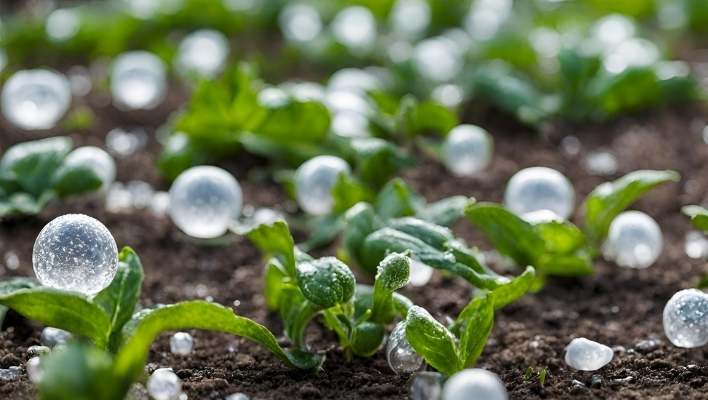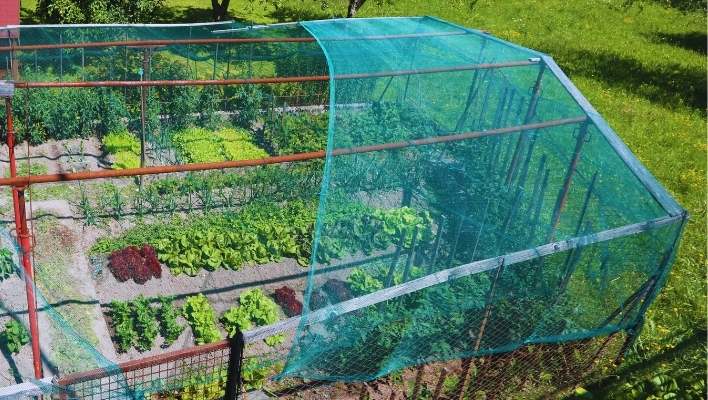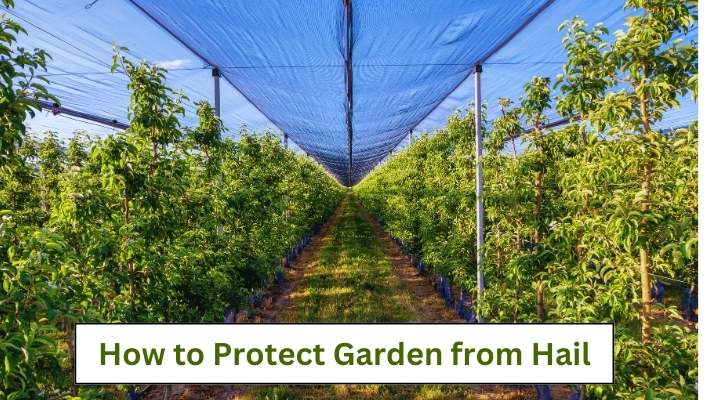To protect your garden from hail, cover plants with netting or row covers to shield them from impact and damage. Gardeners are often faced with the challenge of protecting their plants from natural elements like hail.
Hailstorms can cause significant damage to gardens, destroying delicate flowers, young seedlings, and even mature plants. It is essential to take preventive measures to safeguard your garden from hail. This article will provide some effective methods to protect your garden from hail, ensuring your plants remain healthy and thriving.
By following these steps, you can minimize the potential damage caused by hail and maintain the beauty and productivity of your garden.
Table of Contents
Understanding Hail Damage
Gardening enthusiasts are well aware of the unpredictable nature of weather and its potential to wreak havoc on their beloved plants. One such natural phenomenon that can cause significant damage to gardens is hail. Hail can be incredibly destructive, leaving plants bruised, battered, and worse for wear. To effectively protect your garden from hail, it is essential to understand the impact it can have on your plants and the types of damage it can cause.

Types Of Damage Caused By Hail
When hail strikes, it can cause various types of damage that can negatively impact the health and appearance of your garden. Understanding these types of damage will help you recognize the signs and take appropriate action:
1. Leaf Bruising
Hailstones can bruise the leaves of plants, resulting in dark spots or discolouration. Leaf bruising may seem minor at first, but it can weaken the plant and make it more susceptible to diseases and pests. It is important to inspect your plants after a hailstorm for any signs of bruising.
Read Also: How to Use a Garden Weasel
2. Stem or Branch Breakage
Hailstones, especially larger ones, can cause severe damage to plant stems and branches. They can break or snap them, leaving plants vulnerable to infections, diseases, and even death. Inspect your plants for any broken or damaged stems and prune them if necessary to promote healthy growth.
3. Fruit and Flower Damage
Delicate flowers and developing fruits are particularly susceptible to hail damage. Hailstones can bruise or puncture them, leading to deformities, rot, or premature dropping. It is disheartening to see the fruits of your labour destroyed by hail, but prompt action can sometimes save the remaining produce.
Impact Of Hail On Plants
Now that you are familiar with the types of damage hail can cause, it’s important to understand the overall impact it can have on your plants:
- Reduced Photosynthesis: When leaves are damaged, their ability to carry out photosynthesis may be compromised. This can hinder the plant’s ability to produce food and energy, ultimately stunting its growth and development.
- Weakened Immune System: Hail damage weakens the plant’s immune system, making it more susceptible to diseases, infections, and pests. It is crucial to take preventive measures and provide proper care to boost your plants’ resilience.
- Delayed Flowering and Fruit Set: Hail damage can disrupt the normal growth cycle of plants, causing delays in flowering and fruit sets. This can directly affect the yield and overall health of your garden.
- Protecting your garden from hail is not just about immediate protection during a storm, but also about providing the necessary care and attention to help your plants recover from the damage inflicted. By understanding the types of damage caused by hail and its impact on plants, you can implement effective strategies to safeguard your garden and minimize the potential for long-term harm.
Assessing Garden Vulnerabilities
Gardens are vulnerable to various threats, and one that can wreak havoc on your plants is hail. Hailstorms can cause significant damage, leaving plants battered and broken. However, by assessing your garden’s vulnerabilities, you can take proactive measures to protect your precious plants. Read on to learn how to identify vulnerable plants, evaluate your garden layout, and recognize potential risks.
Identifying Vulnerable Plants
Some plants are more prone to hail damage than others. Certain characteristics make plants more susceptible, such as delicate foliage, thin stems, and shallow root systems. To identify your vulnerable plants:
- Inspect the foliage: Look for plants with large, tender leaves that could easily get shredded by hailstones.
- Check stem thickness: Thin, spindly stems are more likely to snap under the weight of hailstones.
- Assess root depth: Plants with shallow root systems are less stable and can easily be uprooted by strong winds accompanying hailstorms.
Once you’ve identified your vulnerable plants, take note of their locations in your garden for future protective measures.
Evaluating Garden Layout
The layout of your garden plays a crucial role in its vulnerability to hail damage. If your garden is situated in an open area with no barriers, it becomes a prime target for hailstones. To evaluate your garden layout:
- Observe surroundings: Take note of nearby structures, fences, or walls that may offer some protection against hailstones.
- Analyze elevation: Is your garden located in a lower or higher area? Keep in mind that hailstones tend to accumulate in lower-lying areas.
- Consider topography: Are there natural features like hills, trees, or dense shrubs that can act as a shield against hail?
By assessing your garden’s layout, you can identify areas that need additional protection or potentially relocate vulnerable plants to safer spots.
Recognizing Potential Risks
Hailstorms often come with other risks that can further damage your garden. Being aware of these risks allows you to take comprehensive precautions. When assessing potential risks:
- Examine weather patterns: Research the frequency and severity of hailstorms in your region, as well as the time of year they are most likely to occur.
- Take note of nearby landmarks: Are there tall structures or trees that could shed debris during a storm?
- Consider soil condition: Is your soil well-drained? Excessive water retention can lead to root rot and weaken plants, making them more susceptible to hail damage.
By recognizing these potential risks, you can implement preventive measures such as installing hail netting, using protective covers, or adjusting your gardening techniques.
Assessing your garden’s vulnerabilities is a crucial step in protecting your plants from hail damage. By identifying vulnerable plants, evaluating your garden layout, and recognizing potential risks, you can take proactive steps to safeguard your garden and ensure its continued beauty and vitality.
Preparing For Hail
When it comes to protecting your garden from hail, it’s essential to be prepared. Hailstorms can cause significant damage to plants, leaving you with a lot of hard work to recover. By taking proactive measures, you can minimize the impact of hail and preserve the health and beauty of your garden. In this section, we will explore the various strategies you can employ to safeguard your garden from hail, including choosing the right protective measures, installing hail netting, and creating a makeshift hail shelter.
Choosing The Right Protective Measures
When selecting protective measures for your garden, it’s important to consider the size and location of your plants. Different plants may require different forms of protection.
- Hail Netting: One effective method is to install hail netting over your most vulnerable plants. Hail netting is a mesh fabric that creates a barrier against hailstones. It allows sunlight and rain to pass through while reducing hail impact. When selecting hail netting, make sure to choose a suitable size that adequately covers the plants you want to protect.
While hail netting offers excellent protection, it may not be practical for larger gardens or areas with numerous plants. In these cases, alternative methods may prove more feasible.
Installing Hail Netting
If you decide to go with hail netting, here’s a step-by-step guide to installing it:
- Measure the area you want to protect using a tape measure.
- Purchase enough hail netting to cover the measured area, ensuring the mesh size is appropriate for your needs.
- Use wooden stakes or metal posts to create a frame around your plants.
- Drape the hail netting over the frame, making sure it covers the entire area.
- Secure the netting to the stakes or posts using clips or zip ties.
- Regularly inspect the netting for any signs of damage and repair or replace as necessary.
Creating A Makeshift Hail Shelter
In some cases, you may not have the time or resources to install hail netting. Creating a makeshift hail shelter using common household items can provide temporary protection for your plants.
- Identify a suitable location where you can set up the shelter, such as a covered patio, garage, or carport.
- Gather sturdy materials like old blankets, tarps, or thick plastic sheets.
- Stretch the materials over a framework of poles or tall stakes, ensuring they are secured firmly.
- Place the shelter over your most vulnerable plants, ensuring they are completely covered.
- Weigh down the edges of the materials with heavy objects to prevent them from blowing away during strong winds.
This makeshift hail shelter should provide temporary protection until the hailstorm passes. Remember to remove the shelter once the danger has subsided to allow normal growth and ensure the plants receive sufficient sunlight.
Implementing Protective Practices

Protect your garden from hail with effective protective practices. Shield your plants with netting, erect shelters, or move potted plants indoors to minimize damage. Taking precautions can help safeguard your garden and preserve its beauty.
Using Mulch As A Protective Layer
One effective way to protect your garden from hail damage is by implementing the use of mulch. Mulch not only helps improve the overall appearance of your garden but also acts as a protective layer for your delicate plants. Mulch acts as a natural shield, absorbing the impact of hailstones and reducing the risk of damage to your plants. It also helps to retain moisture in the soil, preventing it from quickly evaporating during hailstorms.
Read Also: How to Use Garden Digamajig
When using mulch as a protective layer, it is important to choose the right type of mulch for your garden. Organic mulch such as straw, shredded leaves, or wood chips are great options as they provide additional benefits to your plants. Mulch should be applied in a thick layer around your plants, creating a barrier between the hailstones and the soil. This layer of mulch will not only protect your plants from direct impact but will also help reduce the force of the hailstones as they hit the ground.
Covering Delicate Plants With Buckets Or Upside-down Pots
For smaller plants or delicate flowers that cannot withstand the force of hailstones, a simple and effective method of protection is to cover them with buckets or upside-down pots. By placing a bucket or pot over your plants, you create a shelter that shields them from the impact of hail. This method is particularly useful for potted plants or smaller fragile plants that may not have the same resilience as larger shrubs or trees.
When using buckets or pots as protective covers, make sure to choose containers that are large enough to fully cover the plant without causing damage. Secure the buckets or pots in place to ensure they don’t get blown away during strong winds. After the hailstorm has passed, remember to remove the covers to allow the plants to receive sunlight and fresh air.
Utilizing Row Covers For Larger Garden Areas
For larger garden areas or rows of crops, utilizing row covers is an effective approach to protect your plants from hail damage. Row covers are lightweight, breathable fabrics that can be easily draped over rows of plants. These covers act as a protective barrier, shielding your plants from hail while still allowing sunlight, water, and air to reach them.
When using row covers, make sure to secure them firmly to prevent them from blowing away during strong winds. Lightweight frames or stakes can be used to support the covers and keep them in place. Additionally, it is important to select row covers with the appropriate thickness, depending on the severity of the hail threat in your area.
By implementing these protective practices, you can minimize the risk of hail damage to your garden and ensure the continued growth and health of your plants.
Reacting To Hail Warning
Protect your garden from hail by taking proactive measures like covering delicate plants with blankets or netting, moving potted plants indoors, and providing sheltered areas.
When hail threatens your garden, being prepared and taking quick action is crucial to minimize potential damage. Reacting to a hail warning involves key steps such as monitoring weather forecasts, taking immediate action to protect your garden, and minimizing damage after the hailstorm. Let’s delve into each of these steps and learn how to shield your garden from the destructive force of hail.
Monitoring Weather Forecasts
Keeping an eye on weather forecasts is essential to react promptly to a hail warning. By monitoring weather reports and using reliable weather apps or websites, you can stay informed about the likelihood of hail in your area. Look out for the following indicators:
- Severe thunderstorm warnings
- Hail watches or warnings
- Reports of hail in nearby areas
When hail is predicted, it’s time to take action and protect your garden.
Taking Quick Action To Protect The Garden
When you receive a hail warning, it’s important to act swiftly to safeguard your garden from potential damage. Here are some steps to take:
- Bring potted plants indoors: Move any potted plants under a solid shelter, such as a garage or shed. This will shield them from the hail and prevent damage to their delicate foliage.
- Cover vulnerable plants: For larger plants that cannot be moved, use suitable covers to shield them from hail. This can be in the form of commercial plant covers, blankets, or even upside-down buckets. Ensure the covers are secure and tightly fitted to provide adequate protection.
- Install shade cloth: If hailstorms are frequent in your area, consider installing shade cloth above your garden beds. This will act as a barrier, reducing the impact of hail on plants and minimizing potential damage.
- Use hail nets: If you have fruit-bearing trees or sensitive plants, investing in hail nets can be a wise choice. These nets provide a physical barrier against hailstones and protect your plants from injury.
By taking proactive measures to shield your garden, you can significantly reduce the risk of damage caused by hailstorms.
Minimizing Damage After A Hailstorm
Even with the best preventive measures, your garden may still suffer some damage after a hailstorm. However, there are steps you can take to minimize further harm and help your plants recover more quickly. Consider the following post-hailstorm actions:
- Clear debris: Remove fallen leaves, broken branches, and any other debris caused by the hailstorm. This will prevent them from harbouring pests or promoting fungal diseases.
- Prune damaged foliage: Trim off any damaged or broken leaves, stems, or branches. Pruning encourages new growth and assists in the recovery of your plants.
- Apply organic fertilizers: Boost your plants’ resilience and recovery by applying organic fertilizers that promote healthy growth. This will help replenish nutrients and encourage stronger plants.
- Provide extra care: Give your plants extra attention after a hailstorm. Adequate water, protection from extreme temperatures, and regular observation will aid in their recovery process.
Although hailstorms can be devastating, with proper proactive measures and post-storm care, your garden can bounce back and thrive once again.
How Can I Protect My Garden From Hail?
To protect your garden from hail, you can cover it with a hail netting or use row covers made of sturdy material. If hail is expected, you can also move potted plants indoors or under a cover. Pruning tall trees can also help reduce the impact of hail on your garden.
Read Also: How to Survive a Garden Gnome Attack
Conclusion
To ensure your garden is protected from hail, it’s crucial to take proactive measures. By implementing strategies such as installing protective netting, creating a sheltered spot, and choosing resilient plant varieties, you can minimize hail damage. Regular maintenance and staying updated with weather forecasts will also help you stay one step ahead.
Securing your garden against hail will not only preserve your hard work but also allow your plants to thrive in a safe environment. Take the necessary steps now to safeguard your garden and enjoy the bountiful rewards it brings.



